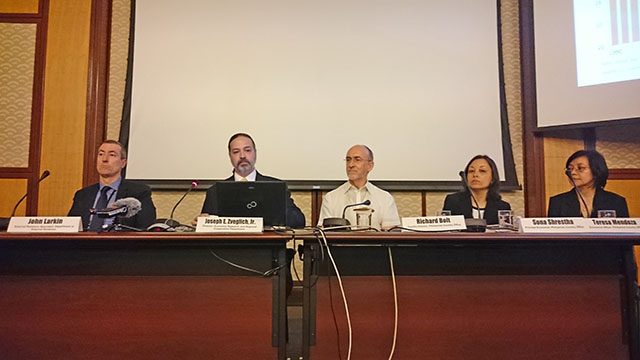SUMMARY
This is AI generated summarization, which may have errors. For context, always refer to the full article.

MANILA, Philippines – Developing Asia is poised for its slowest growth since the start of the millennium but the Philippines, buoyed by increased government spending, remains a bright spot in the region, according to the Asian Development Bank (ADB).
ADB now projects growth for the country coming in at 6% for 2015 , down from its earlier projection of 6.4%, in an update of its annual flagship economic publication the Asian Development Outlook 2015. (READ: ADB maintains growth forecast for PH)
For 2016, growth is seen to improve to 6.3%, unchanged from ADB’s earlier projection.
“After a slow start to the year we are now seeing a pickup in fiscal spending which combined with spending linked to the May 2016 elections will help lift the domestic economy,” said Richard Bolt, the ADB country director for the Philippines in a briefing held on September 22.
The country registered its slowest growth in 3 years in the first quarter of the year, registering a flat 5%, while second quarter GDP results reflected an improvement of 5.6%.
ADB explained in the updated report that growth came under pressure due to a manufacturing slowdown caused by weakened global demand for exports and flat agricultural output caused by El Niño.
Government underspending, which fell below target producing a small fiscal surplus, was also a major factor.
In recent months the peso also came under pressure , dropping 4.6% against the US dollar by mid-September, as global volatility took hold of global markets causing foreign funds to exit developing markets.
Consumption and private investment, however, remained robust through this period supported by higher employment, low inflation, and continued OFW remittances.
Low growth rate for Asia
The Philippines’ rosy outlook, however, is the opposite of the overall growth prospects for the rest of the region.
ADB’s updated report sees GDP growth for developing Asia this year to be at 5.8%, improving only slightly to 6% for 2016.
“The projected growth rate for developing Asia this year is the lowest since the 4.1% recorded in 2011. Before that, even during the global financial crisis of 2008 2009 growth had remained at around 6.1%,” said ADB Assistant Chief Economist Joseph Zveglich.
The chief culprits, he said, were the softer growth of the region’s main engines China and India, as well as developed nations.
China’s has been hit with a stock market crisis and weak exports this year and its growth is now expected at 6.8% for 2015, down from an earlier projection of 7.2%.
Southeast Asia has borne the brunt of China’s slowdown with the region seen at 4.4% before improving to 4.9% in 2016.
India’s slower than expected pace of enacting reforms has seen its projection cut to 7.4% from an earlier 7.8%.
ADB also projected growth in developed nations to ease to 1.9% down from 2.2% in March although there are positive signs with the improved prospects of the EU and continued growth in the US.
Despite this the slower growth, ADB still expects Asia to continue its role as the world’s biggest contributor to global GDP although it may need reforms in order to remain resilient.
“Emerging markets are facing receding capital flows and depreciating currencies—a trend that may be exacerbated by the upcoming rise in US interest rates,” the ADB report stated. “Implementing macroprudential policies and developing local currency bond markets can bolster financial system resilience and mitigate risks to borrowers.”
PH growth drivers
In the near future, the pickup in Philippine government spending that began in the second quarter should accelerate, Bolt said, as the government has taken specific measures to enhance budget execution and placed a particular focus on public private partnership projects (PPPs).
Public expenditure excluding interest, he shared, has accelerated since April growing by 31% year on year from July 2014, with a substantial increase in construction.
The government budget for 2016 is its record largest and includes a 2224.4% increase for the PPP center enabled by the Project Development and Monitoring Facility (PDMF).
Election-related spending will also boost growth through to May of next year, Bolt said.
He added that exports are likely to improve in 2016 as growth in developed markets picks up although inflation is likely to creep up to 3% as oil and other commodity prices are forecasted to rise.
Private investment and household consumption should continue to grow given low inflation and employment and remittances remaining solid, the ADB report stated, with services such as BPOs, tourism and retail leading the way.
ADB said that the main risk to growth are slower than expected economic recovery in developed countries and China as well as a severe El Niño, which would not only hurt the agricultural sector but also affect food, water and electricity prices. – Rappler.com
Add a comment
How does this make you feel?
There are no comments yet. Add your comment to start the conversation.